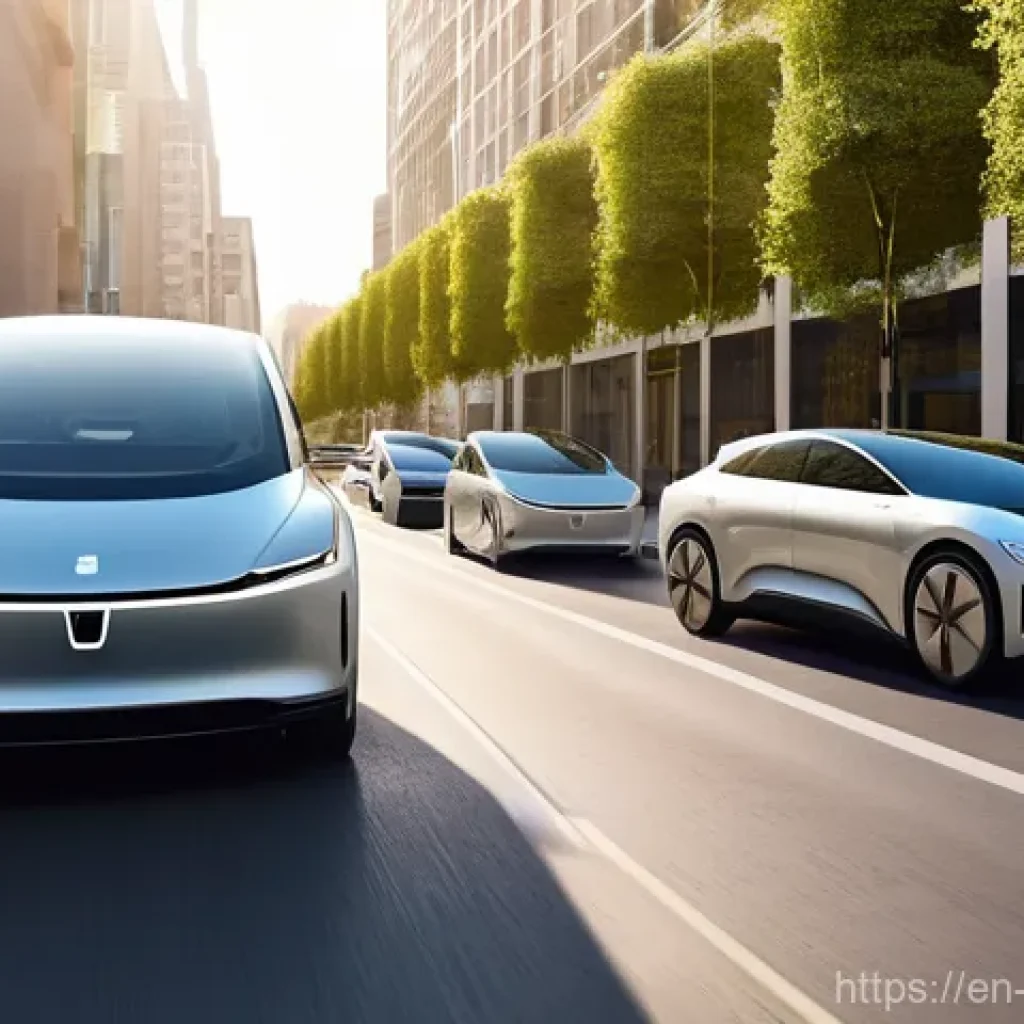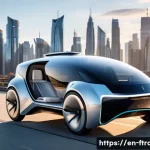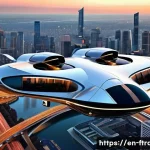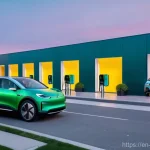Hey there, future-forward friends! Have you ever found yourself stuck in traffic, gazing up at the sky and wishing for a magic carpet or maybe even a personal jetpack?
I totally get it. For years, the idea of “next-generation transportation” felt like something out of a sci-fi flick, always just out of reach. But let me tell you, what’s happening right now is far from fiction – it’s an exciting, tangible revolution that’s redefining how we move.
From silent electric vehicles humming along smart roads to the tantalizing promise of urban air mobility, we’re on the cusp of a truly transformative era.
I’ve been personally watching these trends closely, and the pace of innovation is absolutely blowing my mind, making our daily commutes and long-distance journeys faster, greener, and smarter than ever before.
This isn’t just about speed; it’s about reclaiming our time, protecting our planet, and experiencing a seamless journey that truly feels like the future is here.
Let’s accurately delve into what’s driving this incredible shift!
The Quiet Revolution on Our Roads: Electric and Autonomous
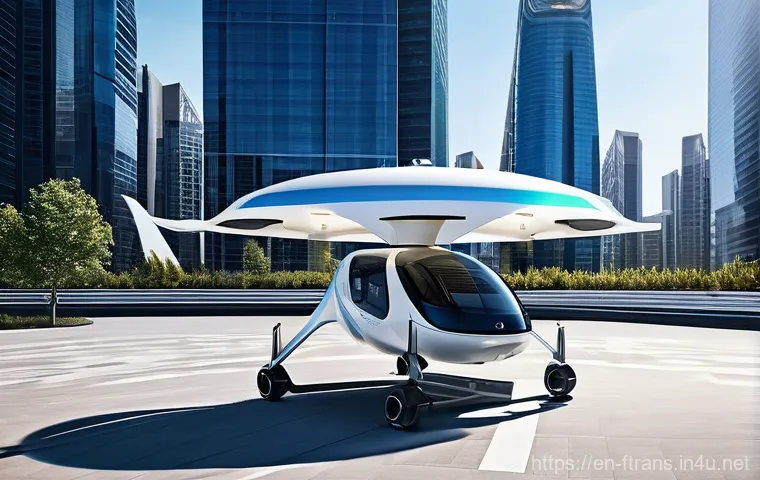
Honestly, when I first heard about electric vehicles becoming mainstream, I was a bit skeptical. Range anxiety was a real thing for me, and the idea of charging felt like a hassle. But let me tell you, experiencing it firsthand completely changed my tune. The silent hum of an EV is just something else; it’s so peaceful, and the instant torque is genuinely exhilarating. It’s not just about getting from point A to point B anymore; it’s about a smoother, quieter journey that genuinely makes you feel like you’re part of something bigger. I’ve personally witnessed the charging infrastructure grow exponentially, making road trips a breeze rather than a worry. This shift isn’t just about saving on gas; it’s a fundamental change in our relationship with our cars, pushing us toward a cleaner, more sustainable future, and I am absolutely here for it. The acceleration, the low maintenance—it’s addictive, and once you try it, it’s tough to go back to conventional combustion engines. It’s a total game-changer for daily commutes and weekend adventures alike, opening up new possibilities for how we experience driving.
The Electric Vehicle Boom: More Than Just a Car
It’s fascinating to watch how quickly electric vehicles have moved from niche curiosities to everyday staples. I remember just a few years ago, seeing a Tesla was a rare event, but now, every other car on the highway seems to be sporting an electric badge. This isn’t just a fad; it’s a powerful movement driven by a combination of environmental consciousness, technological advancements, and frankly, some seriously cool designs. Brands are pouring resources into making EVs accessible and desirable, offering models that fit every lifestyle, from rugged SUVs to sleek sedans. The battery technology is advancing at a dizzying pace, giving us more range and faster charging times. From my perspective, owning an EV is about embracing innovation and making a tangible difference, however small, in reducing our carbon footprint. It feels good, and the growing community around EVs makes it even better. There’s a certain pride that comes with driving a car that’s part of the solution, not the problem.
Self-Driving Cars: Gaining Our Trust
Now, autonomous vehicles, that’s a whole different ballgame. I’ll admit, the first time I was in a car that pretty much drove itself on a highway, my hands were hovering over the wheel, ready to take over at any second. It felt strange, almost surreal. But as the technology matures, and particularly with features like advanced cruise control and lane-keeping assistance becoming standard, I’m starting to see the incredible potential. Imagine commuting without the stress of stop-and-go traffic, or being able to catch up on emails during a long drive. While fully autonomous Level 5 vehicles are still a bit down the road for everyday use, the incremental progress is undeniable and truly exciting. The key, I think, is building trust through robust safety standards and clear communication about what these systems can and cannot do. It’s a journey, not a destination, and I’m eager to see how human drivers and autonomous systems will learn to coexist and complement each other, especially as regulations catch up with the tech. This is going to fundamentally change how we perceive travel time.
Soaring to New Heights: The Promise of Urban Air Mobility
For years, the idea of flying cars felt like something pulled straight out of a Jetsons cartoon – fun to imagine, but utterly impractical. Yet, here we are, witnessing the birth of urban air mobility (UAM) with eVTOLs (electric Vertical Take-Off and Landing vehicles) leading the charge. I’ve been following the developments closely, and the thought of hopping into an air taxi to skip rush hour traffic truly blows my mind. The vision is incredible: silent, electric aircraft ferrying people across cities, dramatically cutting down commute times and offering a bird’s-eye view of the urban landscape. It’s not just about speed; it’s about reclaiming countless hours we currently spend stuck in gridlock. Of course, there are immense challenges – air traffic control, noise considerations, public acceptance, and the sheer cost – but the progress being made by companies worldwide is genuinely inspiring. This isn’t just a dream; it’s a tangible goal that brilliant minds are working towards every single day. The potential for a paradigm shift in how we navigate our cities is truly enormous, and I’m optimistic about what the next decade holds for this exciting frontier.
eVTOLs: Your Future Air Taxi?
The concept of eVTOLs as air taxis feels like the most futuristic thing on this list, doesn’t it? These sleek, often drone-like vehicles are designed to take off and land vertically, just like helicopters, but with the added benefits of electric power: less noise, zero emissions, and potentially lower operating costs. I’ve seen some of the prototypes and simulations, and they are truly stunning. Imagine leaving your office and instead of waiting for a taxi, you head to a nearby vertiport, step into an eVTOL, and within minutes, you’re across town, avoiding all the ground-level chaos. The convenience factor alone is a massive draw. Companies are already running test flights in various locations, perfecting the technology and iron out the operational kinks. While we’re probably a few years away from these being a common sight, the advancements in battery density, electric motor efficiency, and autonomous flight systems make this future feel incredibly close. It’s the kind of innovation that genuinely redefines how we think about urban logistics and personal travel.
Navigating the Skies: Infrastructure and Regulations
As exciting as eVTOLs are, the reality check comes when we consider the massive infrastructure and regulatory hurdles. It’s not just about building the aircraft; it’s about building an entirely new ecosystem. Where will these air taxis take off and land? We’ll need “vertiports” strategically placed throughout cities, integrated with existing transportation networks. Then there’s the monumental task of air traffic management. Imagine hundreds of eVTOLs flying simultaneously over a bustling metropolis – the coordination would need to be absolutely flawless to ensure safety. Regulators, like the FAA in the US or EASA in Europe, are working overtime to develop the certification processes and operational rules for these novel aircraft. It’s a complex dance between innovation and safety, ensuring that while we push the boundaries of what’s possible, we don’t compromise on public trust. My gut feeling is that the initial rollout will be in a very controlled, perhaps semi-private capacity, slowly expanding as the systems and public confidence mature. It’s a monumental undertaking, but the payoff in terms of urban efficiency and reduced congestion could be transformative.
Beyond the Road: Reimagining Long-Distance Travel
While urban mobility gets a lot of buzz, the future of long-distance travel is also undergoing a profound transformation. I often find myself dreading long drives or the endless security lines at airports for relatively short flights. That’s where high-speed rail and futuristic concepts like the hyperloop step in, promising to bridge distances with unprecedented speed and efficiency. I’ve always been envious of countries with extensive high-speed rail networks; the idea of zipping between major cities in comfort, often faster than flying when you factor in airport logistics, just makes so much sense. These aren’t just faster trains; they’re designed as integral parts of a larger intermodal transport system, aiming to make travel as seamless as possible. The environmental benefits are also huge, moving large numbers of people with significantly less carbon footprint than air travel. It truly feels like we’re moving towards a future where how we travel long distances will be dictated by convenience and speed, not just cost.
High-Speed Rail: Connecting Cities Faster
When I think about efficient long-distance travel, my mind immediately goes to high-speed rail. Having experienced it in a few countries, I can confidently say it’s a game-changer. There’s something incredibly appealing about stepping onto a sleek train, grabbing a coffee, and watching the countryside whiz by at hundreds of miles per hour, knowing you’ll arrive in another major city feeling refreshed rather than stressed. It truly bridges the gap between flying and driving for many journeys. The infrastructure investment is significant, no doubt, but the long-term benefits in terms of economic development for connected regions, reduced road congestion, and lower emissions are undeniable. Imagine being able to commute between cities that are currently a grueling drive or a short but annoying flight away, all while working comfortably or simply relaxing. It transforms regions and makes them feel more connected, fostering both business and leisure travel in a way that’s incredibly sustainable and pleasant. It’s a solution that feels both classic and perfectly suited for the future.
The Hyperloop Dream: Ultra-Fast Ground Transport
Now, if high-speed rail is a leap forward, then the hyperloop is a giant imaginative jump. The concept of propelling passenger pods through near-vacuum tubes at speeds potentially exceeding commercial aircraft is mind-boggling. I remember when the idea was first floated, it sounded like pure science fiction, but the progress made in prototypes and test tracks is absolutely fascinating. Imagine traveling from Los Angeles to San Francisco in under 30 minutes – that’s the kind of transformative power we’re talking about. While there are still monumental engineering and safety challenges to overcome, and the sheer cost of building such a system would be immense, the potential to fundamentally redefine intercity travel is unparalleled. It’s a testament to human ingenuity, constantly pushing the boundaries of what we thought was possible. It’s going to require a massive collaborative effort between governments, engineers, and investors, but if successful, it could truly revolutionize how we perceive distance and connectivity, making our world feel a whole lot smaller and more accessible.
Smart Infrastructure: The Unsung Hero of Tomorrow’s Commute
We often focus on the flashy vehicles – the Teslas, the eVTOLs – but the real magic that makes next-gen transportation work is often hidden beneath our feet and within the very fabric of our cities. I’m talking about smart infrastructure, the unsung hero that’s quietly revolutionizing how our entire transportation ecosystem functions. For years, I’d get so frustrated with inexplicable traffic jams or finding myself circling for ages to find parking. But with smart roads, connected traffic lights, and intelligent sensors, our commutes are becoming significantly more efficient and less stressful. This isn’t just about avoiding bottlenecks; it’s about dynamically optimizing traffic flow, anticipating congestion, and even communicating directly with vehicles to suggest the most efficient routes. It’s like our cities are developing a nervous system, constantly learning and adapting to improve mobility for everyone. This interconnectedness is absolutely vital for the success of autonomous vehicles and urban air mobility, creating a seamless, responsive network that truly feels like it’s thinking ahead.
Connected Roads and Smart Cities
The vision of truly smart cities where everything is interconnected is starting to become a tangible reality, and connected roads are a huge part of that. Imagine roadways embedded with sensors that can detect traffic density, identify accidents in real-time, and even communicate with your car to warn you of hazards ahead. It’s not just about efficiency; it’s about safety. These smart roads can collect data that helps urban planners optimize routes, reduce emissions, and even prioritize public transport. From my perspective, this level of integration is incredibly exciting because it moves beyond just individual vehicles to creating a holistic system where the entire environment is working to improve our travel experience. It’s a proactive approach to urban planning that transforms our grey infrastructure into something dynamic and intelligent, ultimately making our cities more livable and enjoyable. The real-time data flow is the superpower here, allowing for unprecedented levels of coordination and responsiveness.
Intelligent Traffic Management
Intelligent traffic management systems are like the brains of our urban transportation networks, constantly analyzing data and making real-time adjustments. Gone are the days of rigid, timed traffic lights that cause bottlenecks even when there’s no cross-traffic. With AI-powered systems, traffic lights can dynamically adjust based on actual traffic flow, prioritizing busy intersections or giving green waves to emergency vehicles. I’ve noticed this already in a few pilot cities, and the difference in commute times is remarkable. It’s about leveraging vast amounts of data – from vehicle sensors, roadside units, and even public transit schedules – to create the most efficient movement of people and goods possible. This level of optimization not only reduces travel times but also cuts down on idling, which means less pollution and less wasted fuel. It genuinely feels like our cities are becoming smarter, more responsive entities, capable of adapting to the unpredictable rhythms of urban life. It’s a subtle change you feel more than see, but the impact is profound.
Powering the Future: Sustainable Energy and Charging Innovations

The shift to next-generation transportation isn’t just about the vehicles themselves; it’s fundamentally about how we power them. I mean, what’s the point of a silent, emission-free electric car if the electricity comes from dirty sources, right? This is where sustainable energy and charging innovations become absolutely critical. I’ve personally experienced the early days of EV charging, which sometimes felt like a scavenger hunt. But now, it’s a whole different ballgame. We’re seeing a rapid expansion of charging networks, faster charging speeds, and incredible advancements in how we generate and store energy. This comprehensive approach – from renewable energy sources like solar and wind to smart grids and cutting-edge battery technology – is what makes the future of transportation truly sustainable and viable. It’s a dynamic and fast-moving field, and the continuous innovation in this area gives me so much hope for a truly green future, where our commutes contribute to a healthier planet, not detract from it. The symbiosis between clean energy and clean transport is truly beautiful to behold.
The Evolution of Charging: Faster, Smarter, Everywhere
If you’re still picturing slow, clunky charging stations, you’re living in the past! The evolution of EV charging has been nothing short of phenomenal. I remember being concerned about long charging times, especially on road trips. But now, with ultra-fast DC chargers, you can add hundreds of miles of range in the time it takes to grab a coffee and stretch your legs. It’s a far cry from the overnight charging of early models. What’s even cooler is how charging is becoming smarter – integrating with home energy management systems, optimizing charging times based on electricity rates, and even enabling vehicle-to-grid (V2G) technology, where your car can send power back to the grid during peak demand. This isn’t just about convenience; it’s about making EVs an integral part of a resilient, sustainable energy ecosystem. The sheer accessibility of charging, from public stations to workplace chargers and even lamp posts, is making range anxiety a relic of the past for many drivers. The pace of this change is truly inspiring.
Beyond Batteries: Exploring New Energy Sources
While batteries are the current darlings of electric mobility, the quest for even more sustainable and efficient energy sources is relentless. I’ve been fascinated by the ongoing research into hydrogen fuel cells, which offer fast refueling and long range with only water vapor as an emission. While the infrastructure for hydrogen is still nascent, the potential for heavy-duty transport, like trucks and trains, is enormous. There’s also constant innovation in battery chemistry, aiming for lighter, more powerful, and cheaper batteries that don’t rely on rare earth materials. Some researchers are even looking into advanced biofuels for hybrid systems or next-generation synthetic fuels. This multi-pronged approach is crucial because no single solution will fit every transportation need. It’s about diversifying our energy portfolio and ensuring that our future mobility is not only emission-free but also resource-efficient and adaptable to different scales and applications. It’s a reminder that innovation never truly stops, constantly pushing the boundaries of what’s possible in the pursuit of cleaner energy. This ongoing exploration ensures our transition to green transport is robust and future-proof.
The Human Element: Adapting to a New Era of Mobility
As we talk about all these incredible technological advancements, it’s easy to forget that at the heart of it all are people. How *we* adapt to this new era of mobility is just as crucial as the technology itself. I’ve personally found my perspective shifting from car ownership as a status symbol to viewing transportation as a service, a means to an end. It’s a fascinating psychological shift. This isn’t just about changing how we get around; it’s about changing our relationship with personal freedom, urban spaces, and even our daily routines. The advent of car-sharing, ride-hailing, and even subscription services for vehicles shows that many are embracing access over outright ownership. The implications for urban planning are immense, too. Imagine cities with fewer parking lots, more green spaces, and streets designed for people, not just cars. It’s a future that puts well-being and community at the forefront, leveraging technology to create more humane and sustainable environments. This adaptation is a journey for all of us, and it promises to reshape our lives in profound, often unexpected, ways.
Shifting Mindsets: From Ownership to Access
I genuinely believe one of the biggest, yet most subtle, revolutions happening is the shift in our mindset about car ownership. For generations, owning a car represented freedom, independence, and a rite of passage. But with the rise of ride-sharing apps, car-sharing services, and the increasing cost of vehicle ownership (insurance, maintenance, parking!), I’ve noticed a distinct trend towards valuing access over outright ownership. Especially in urban areas, the convenience of summoning a ride whenever you need it, or easily renting a car for a weekend trip, is incredibly liberating without the financial burden and hassle of owning a depreciating asset. It opens up a world of possibilities for those who previously couldn’t afford a car or simply didn’t want the associated responsibilities. This cultural evolution is a powerful driver for sustainable mobility, reducing the total number of vehicles on the road and optimizing their use. It’s a pragmatic approach that aligns perfectly with a more connected and resource-efficient future, allowing us to enjoy the benefits of mobility without the traditional drawbacks.
The Impact on Urban Planning and Lifestyles
The ripple effect of next-gen transportation on urban planning and our daily lifestyles is something I find incredibly exciting. Imagine a city where vast swaths of land currently dedicated to parking lots can be transformed into parks, community spaces, or affordable housing. With fewer privately owned cars and more efficient public and shared transport options, cities can be redesigned around people, not vehicles. Think about how much quieter and safer our streets could become with electric and autonomous vehicles, reducing noise pollution and accidents. This could lead to a renaissance of walkable neighborhoods, vibrant public squares, and a renewed focus on local businesses. Our daily commutes could become opportunities for relaxation or productivity, rather than stress. It’s about reclaiming urban space and time, fostering healthier, more connected communities. This transformation will require visionary leadership and collaborative planning, but the potential for creating truly livable, future-proof cities is absolutely immense and incredibly inspiring. It’s a chance to build better places for everyone.
| Transportation Mode | Key Benefit | Current Challenge |
|---|---|---|
| Electric Vehicles (EVs) | Zero tailpipe emissions, quiet operation, instant torque | Charging infrastructure availability, battery cost/lifecycle, range anxiety |
| Urban Air Mobility (UAM) | Significantly reduced urban travel times, bypass ground congestion | Regulatory hurdles, air traffic control, public acceptance, noise concerns |
| High-Speed Rail (HSR) | Fast, efficient inter-city travel, lower carbon footprint than air travel | High infrastructure costs, land acquisition, political will |
| Autonomous Vehicles (AVs) | Reduced human error accidents, increased productivity for passengers, optimized traffic flow | Safety and liability concerns, ethical dilemmas, regulatory framework, public trust |
| Hyperloop | Ultra-high-speed long-distance travel, reduced travel times | Massive infrastructure investment, technological validation, safety protocols |
Tackling the Challenges: Making the Dream a Reality
It’s easy to get swept away by the excitement of a futuristic vision, but as a realist (and someone who’s seen enough tech fads come and go), I know we have to talk about the practical challenges. Making next-generation transportation a widespread reality isn’t just about inventing cool tech; it’s about making it affordable, safe, and accessible to everyone. The sheer scale of infrastructure development required, whether for charging networks, vertiports, or hyperloop tubes, is monumental and will require significant investment and collaboration between governments and private sectors. Then there’s the question of public acceptance – will people trust self-driving cars or feel comfortable flying in an air taxi? These are not trivial concerns. But honestly, I’ve always been an optimist when it comes to human ingenuity. History shows us that with enough drive and collaboration, we can overcome seemingly insurmountable obstacles. It’s going to be a bumpy road, filled with trials and errors, but the potential rewards – a cleaner, faster, and more connected world – are absolutely worth fighting for.
The Price Tag and Accessibility Question
Let’s be real for a moment: cutting-edge technology often comes with a hefty price tag. Right now, many of these next-gen transportation options, from the latest EVs to the conceptual eVTOLs, are simply out of reach for the average person. If we want this transportation revolution to truly benefit society, it needs to be accessible, not just a luxury for the privileged few. This means finding ways to drive down manufacturing costs, investing in public subsidies, and developing robust shared-mobility models that make these innovations available to a wider audience. It’s a critical challenge because if these solutions remain exclusive, they won’t solve the broader issues of congestion, pollution, and inefficient travel that plague our current systems. My hope is that as economies of scale kick in and governments prioritize sustainable transport, the costs will decrease, and these transformative technologies will become a standard part of our everyday lives. It’s about ensuring equity in this exciting new future.
Safety, Security, and Public Acceptance
Perhaps the most crucial hurdle for many of these innovations is building public trust, which hinges almost entirely on safety and security. I mean, would you willingly put your family in a self-driving car if you had lingering doubts about its reliability, or step into an air taxi if you questioned its airworthiness? Of course not! Ensuring these systems are incredibly safe, robustly tested, and resilient to cyber threats is paramount. This isn’t just about preventing accidents; it’s about creating a psychological comfort level that encourages widespread adoption. Regulators, manufacturers, and software developers are working tirelessly on this, but it’s a continuous process of rigorous testing, transparent reporting, and constant improvement. The public needs to feel confident that the systems are not only capable but also secure from malicious attacks. This social and ethical dimension is just as important as the technological one, and without addressing it head-on, even the most brilliant innovations might struggle to gain a firm footing in our daily lives. It’s a conversation we all need to be a part of, collectively shaping a future we can all trust.
Wrapping Things Up
Whew! What an exhilarating ride through the future of how we move. Honestly, diving deep into these innovations always leaves me buzzing with excitement and a genuine sense of hope. It’s not just about the shiny new tech, though that’s certainly part of the appeal. For me, it’s about the profound impact these changes will have on our daily lives, our cities, and ultimately, our planet. I truly believe we’re on the cusp of a mobility renaissance, one where convenience, sustainability, and efficiency aren’t just buzzwords, but tangible realities. It’s a future shaped by human ingenuity and a collective desire for something better, and I, for one, can’t wait to be a part of it, experiencing every silent drive and efficient journey along the way.
Useful Information to Know
1. Start Small with EVs: If you’re hesitant about going fully electric, consider a plug-in hybrid (PHEV) first. It gives you a taste of electric driving for daily commutes while keeping the gasoline engine for longer trips, easing any range anxiety you might have. It’s a fantastic stepping stone, allowing you to adapt to charging routines without a full commitment, and many brands offer great incentives for them too. From my own experience, getting familiar with charging at home first is a game-changer for confidence.
2. Explore Public Transit Upgrades: Even if you’re not ready for an eVTOL, keep an eye on your local public transportation initiatives. Many cities are investing heavily in cleaner, smarter buses, trains, and even bike-share programs, often integrating them with smart apps for real-time tracking. These aren’t just for environmental reasons; they’re designed to make your commute smoother and more predictable, often with dedicated lanes or priority signaling that can genuinely save you time and stress during peak hours.
3. Stay Informed on Autonomous Features: Don’t dismiss self-driving tech entirely! Even if full autonomy feels distant, many new cars come with incredible advanced driver-assistance systems (ADAS) like adaptive cruise control, lane-keeping assist, and automatic emergency braking. Learning how to properly use these features can significantly enhance your safety and reduce driving fatigue. I’ve found that once you get comfortable with them, they become invaluable co-pilots, making long journeys far more relaxing and enjoyable.
4. Consider Mobility-as-a-Service: Think beyond car ownership. For urban dwellers, ride-hailing, car-sharing, and even subscription services for vehicles are becoming increasingly popular. They offer the convenience of a car without the hassle of maintenance, insurance, or parking. This can be a significant financial relief and often means you’re using newer, more efficient vehicles. It’s a different way to think about mobility, focusing on access and utility rather than traditional possession, and it really aligns with a minimalist, city-living lifestyle.
5. Look for Charging Incentives & Infrastructure: If you’re thinking EV, research state and federal incentives for purchase and home charger installation. Many utility companies also offer special off-peak charging rates, which can dramatically lower your operating costs. Plus, download apps like PlugShare or ChargePoint to map out public charging stations for your road trips. The network is growing so fast, and being prepared makes all the difference, especially when you’re venturing to new places. Planning ahead means zero worries on the open road.
Key Takeaways
What we’ve explored today isn’t just a collection of futuristic gadgets; it’s a holistic shift in how we envision and experience travel. The convergence of electric propulsion, autonomous intelligence, advanced urban planning, and sustainable energy sources is paving the way for a truly transformative era. This isn’t a passive change; it requires our active engagement, curiosity, and willingness to adapt to new possibilities. From quieter commutes and cleaner air to more connected communities and rediscovered urban spaces, the benefits of embracing this new mobility paradigm are immense. It’s an exciting time to be alive, witnessing the dawn of a transportation future that promises to be faster, greener, and ultimately, more human-centric than anything we’ve known before.
Frequently Asked Questions (FAQ) 📖
Q: What are the biggest game-changers we’re seeing that will completely transform how we get around in the near future?
A: Oh, this is such a thrilling question, and honestly, it’s one I get asked all the time! From my vantage point, keeping a close eye on all the incredible innovation happening, there are a few absolute titans reshaping our commutes and travels.
First off, autonomous vehicles, or self-driving cars, are way past the “sci-fi dream” stage. We’re seeing real progress, with companies continually advancing sensor fusion—that’s where cars combine data from radar, lidar, and cameras to literally “see” the world in 360 degrees, making split-second decisions like a pro driver.
What really excites me is how AI and machine learning are making these systems smarter with every mile driven, and we’re starting to see level 3 autonomy roll out, where the car can handle most driving tasks under certain conditions.
Imagine getting back your commute time to catch up on emails or just relax! These aren’t just for personal cars either; autonomous taxis and delivery vehicles are already hitting the roads in pilot programs in some major cities, hinting at a future where logistics are smoother and faster than ever before.
Then, of course, we can’t talk about next-gen transportation without gushing about the acceleration of electrification. Electric Vehicles (EVs) are no longer just a niche market; they’re becoming mainstream.
We’re seeing a huge expansion in models, from sleek sedans to rugged trucks, with ranges that are seriously impressive – some even going over 400 miles on a single charge.
This isn’t just about reducing our carbon footprint, which is massive, but also about a quieter, often more powerful driving experience. The charging infrastructure is rapidly evolving to keep up, too, which brings me to my next point!
Finally, and this one often flies under the radar but is absolutely foundational, is the rise of smart roads and intelligent infrastructure. Think of roads that aren’t just asphalt but are living, breathing digital ecosystems.
These aren’t distant dreams; we’re talking about Vehicle-to-Everything (V2X) communication, allowing cars to talk to each other, to traffic lights, and even to pedestrians!
This real-time data exchange is pivotal for optimizing traffic flow, reducing accidents, and making our journeys incredibly smooth. I’ve read about concepts like intelligent lighting systems that adjust based on traffic and even dynamic wireless power transfer lanes that could charge EVs while they drive.
It’s about creating a harmonious, efficient, and super-safe network for all these advanced vehicles. These three areas—autonomous tech, electrification, and smart infrastructure—are truly the pillars holding up our future of transportation.
Q: Everyone talks about flying cars!
A: re urban air mobility solutions really going to be a part of our daily lives soon, and what’s the biggest hurdle we need to overcome? A2: Oh, flying cars!
The dream of every sci-fi enthusiast and, let’s be honest, anyone who’s ever been stuck in rush hour traffic! Urban Air Mobility (UAM), which is essentially the fancy term for those electric vertical takeoff and landing (eVTOL) aircraft and air taxis we’ve been hearing about, is absolutely making incredible strides.
Companies like Joby Aviation and Volocopter are already deep into testing prototypes, and I’ve seen some breathtaking designs that look straight out of a futuristic movie.
The idea is to use the airspace above our cities to ferry passengers and cargo, offering a genuinely swift and often more sustainable alternative to ground-based transport.
Imagine zipping from one side of a sprawling metropolis to another in minutes, silently, without contributing to ground congestion. That’s the promise!
The driving forces behind UAM are pretty compelling: huge leaps in electric propulsion and battery technology, which make these silent, zero-emission flights feasible for short distances.
Plus, the ever-growing problem of urban congestion and pollution means cities are desperate for innovative solutions. From my perspective, UAM could dramatically reduce travel times and even open up new economic opportunities.
But, and this is a big but, the biggest hurdle we need to overcome isn’t necessarily the technology itself – though battery capacity and autonomous flight systems are still being refined.
It’s really about safety, regulation, and public acceptance. Think about it: integrating hundreds, or even thousands, of these air vehicles into already complex urban airspaces requires incredibly robust air traffic management systems.
Regulators need to iron out comprehensive policies for everything from flight routes that don’t disrupt airports to stringent safety standards that build public trust.
We’re talking about making sure these things are incredibly safe, especially if they’re eventually going to be autonomous, operating without a human pilot.
And then there’s the “human factor.” Will people truly feel comfortable with air taxis flying over their homes? What about noise levels, even if they’re quieter than helicopters?
How do we build the necessary “vertiports” – those specialized landing and takeoff hubs – within dense urban environments? It’s a massive undertaking that requires collaboration between engineers, city planners, governments, and the public.
While I’m incredibly optimistic about the potential, I believe building that iron-clad trust and a seamless regulatory framework is going to be the toughest, most crucial step to make UAM a widespread reality.
Q: With so many people buying electric vehicles, is our current charging infrastructure up to the task, and what exciting developments can we expect to see in the future of EV charging?
A: What an astute observation! You’ve hit on one of the most pressing questions for anyone considering making the switch to an EV, or for those of us who already have one.
It’s true, EV sales are skyrocketing globally, and while the charging infrastructure has come a long long way, it’s definitely in a state of rapid evolution, still playing catch-up in some areas.
From my own experience, early on, range anxiety was a real thing – wondering if you’d find a charger on a long trip. But things are getting so much better!
Globally, the network has expanded significantly; we’re talking millions of public charging points now, a huge leap from just a decade ago. We have Level 1 chargers, great for overnight home charging, Level 2 chargers that you see more often in public places and workplaces, and the incredibly fast DC Fast Chargers that can get you to 80% in about 30 minutes, which are popping up all along major highways.
The pace of investment from both governments and private companies is accelerating, and that’s fantastic news. Looking ahead, though, this is where it gets really exciting!
We’re not just talking about more chargers; we’re talking about smarter, faster, and more convenient ways to power up. First, ultra-fast charging is becoming the new standard.
Imagine charging your EV in minutes, not hours. This dramatically cuts down on wait times and makes long-distance travel much more feasible and enjoyable.
Second, wireless charging is on the horizon, and it’s super cool. Think about just parking your car over a charging pad, and it automatically starts charging – no plugs, no fuss.
This technology could become more widespread in parking garages and even in designated lanes on smart roads, effectively charging your car as you drive!
Third, I’m particularly enthusiastic about the integration with renewable energy sources. Many future charging stations will be equipped with solar panels or draw power from wind farms, making EVs an even greener option.
This isn’t just about convenience; it’s about building a truly sustainable transportation ecosystem. Finally, expect to see smarter charging hubs and apps that offer real-time availability, reservation systems, and integrated billing, making the whole experience seamless.
There’s also a big push for strategically placed charging corridors along highways to truly eliminate range anxiety for good. So, while we’re not quite at a charging station on every corner yet, the future promises an infrastructure that’s not only ready for the EV revolution but is also part of an even larger, smarter, and greener energy grid.
